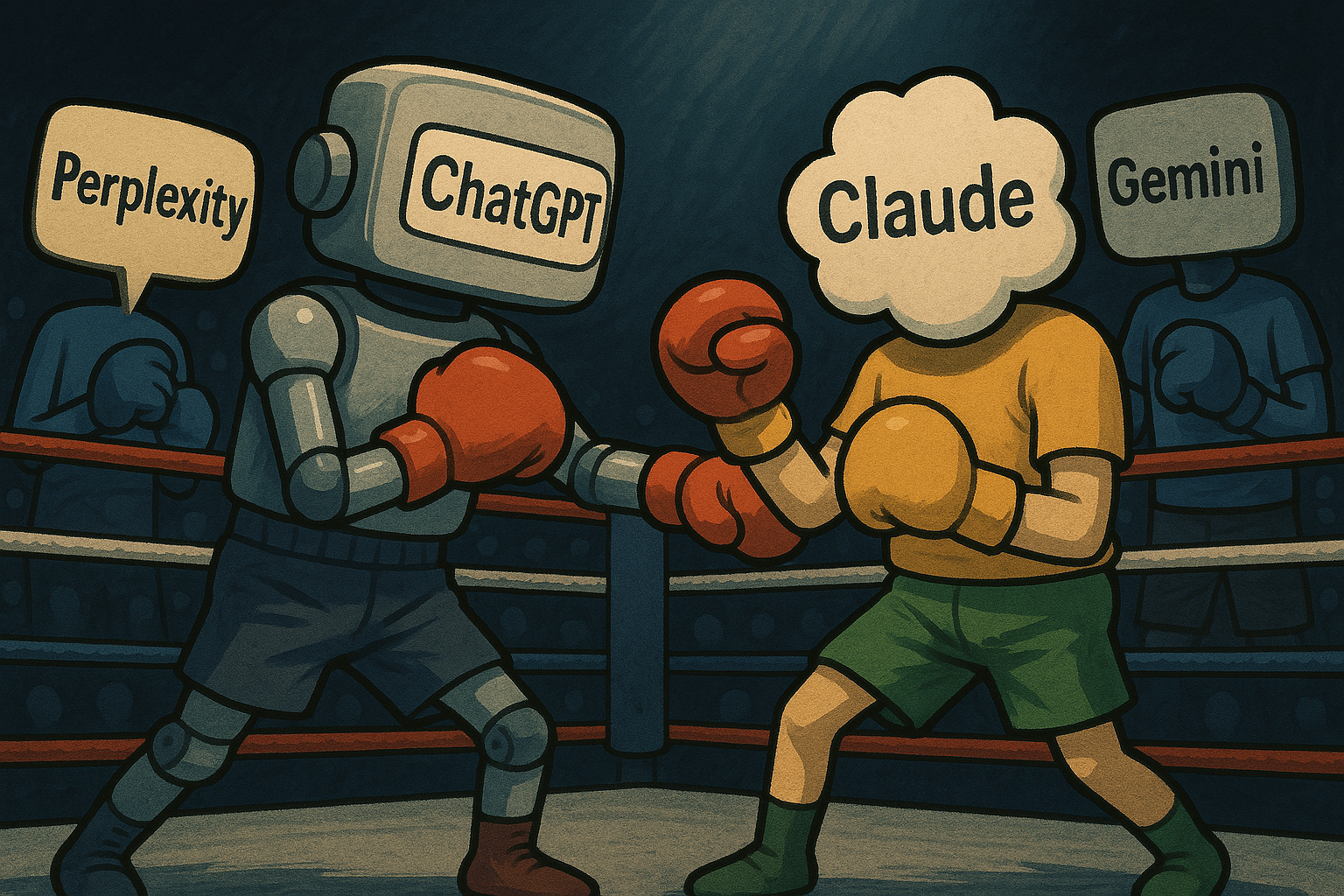From research to creativity, how do four of the top AI platforms differ?
Are all AI platforms created equal? No.
Perplexity, Claude, Gemini, and ChatGPT are all powerful AI systems. Does one stand above the others? It’s not a straightforward question with a simple answer, as it depends on the task at hand.
Each of these AI platforms has unique features tailored to different tasks and user needs, meaning we don’t use one system for everything. (And yes, these are just four of the many strong AI systems available. There are MANY others.)
Our team has used these well-known names for various purposes, often testing the platforms head-to-head to gauge performance. Here’s a breakdown of their differences, strengths, and our take on how and when to use each – we’ll call this our version of the AI showdown.
Core Strengths: Search-focused AI with real-time access, contextual understanding, and citation-backed answers.
Best For:
- Research and Information Retrieval: Perplexity excels in providing reliable, up-to-date information with citations to original sources. It’s ideal for times when one needs trustworthy data quickly.
- Summarization: It can summarize articles, webpages, and documents instantly, saving time for users who need concise overviews.
- Professional Use Cases: Tasks like legal research, financial analysis, SEO optimization, and product management benefit from Perplexity’s ability to provide detailed answers and insights.
When do we use Perplexity?
We turn to Perplexity when we need real-time web search capability and need to find the latest updates on a topic. The platform is transparent with citations and sources, and provides deeper insights with its document upload capability.
Perplexity differentiates itself from other AI platforms by focusing on real-time information retrieval and search functionality. Unlike traditional AI assistants that rely solely on pre-trained knowledge, Perplexity directly searches the internet to provide up-to-date information with cited sources. It combines AI-powered summarization with live web access, allowing users to ask questions and receive answers backed by current online content. Perplexity also emphasizes citation transparency, showing users exactly where information comes from, which builds trust and verifiability.
We appreciate Perplexity’s search-first approach when faced with tasks such as research, fact-checking, and accessing time-sensitive information that may fall outside other AI systems’ knowledge cutoffs.
Here’s an example of how we use ChatGPT AI: In June 2024, the U.S. Olympic swim trials were held at Lucas Oil Stadium in Indianapolis. We wanted to see how unique this venue was for swimming events (answer: very unique!), and find out if there were record-breaking crowds at this event. (answer: the largest single-day crowd EVER to attend a swimming competition was 22,209 spectators, on June 22 during these trials.)
Core Strengths: “Safety-first” AI with advanced reasoning capabilities; as Claude describes itself, it is designed to be “helpful, honest, and harmless” and is a “reliable assistant for long-term projects or sensitive applications.”
Best For:
- Document Analysis: Claude is excellent at analyzing large documents or datasets due to its extended context length.
- Ethical AI Applications: Claude prioritizes “safe and responsible” outputs, making it suitable for educators or businesses concerned about ethical AI use.
- Reasoning Tasks: The platform is ideal for tasks requiring logical problem-solving or in-depth analysis.
- Creative Inspiration: Claude offers excellent ideas for writing projects, scripts, or other similar types of output.
When do we use Claude?
We find that Claude AI excels at producing high-quality, well-reasoned content, and also is skilled at understanding nuanced instructions. It is designed to be a helpful, conversational assistant that can assist with a wide range of tasks while maintaining natural, human-like interactions, all while being transparent about its limitations (if it can’t find the info or cannot answer the question, Claude lets you know).
Here’s an example of how we’ve used Claude AI: For this very blog you are reading now, we tapped into the power of Claude to help frame the discussion and to get some of the finer points developed. From that foundation, a member of the Empirical team further developed and finalized this piece. (So while AI gets some credit for the creation of the piece, there was a lot of human input as well.)
3. Gemini (by Google DeepMind)
Core Strengths: Gemini has capabilities across text, image, and video, and seamlessly integrates into Google’s ecosystem.
Best For:
- Business Users: Gemini integrates deeply with Google Workspace tools like Gmail and Calendar, making it a natural fit for professionals already using Google products.
- Multimodal Tasks: Its ability to process text, images, and videos makes it versatile for creative projects or complex analyses.
- Team Collaboration: Gemini’s integration supports teams working on shared projects within Google’s ecosystem.
When do we use Gemini?
Gemini’s strength is working through tasks that require the combination of different types of inputs. It understands and processes text alongside images, audio, and video – and can analyze visual content, interpret charts or diagrams, and respond to queries that involve multiple media types. Google has integrated Gemini so it works well with Google products and services.
Gemini AI comes in different versions optimized for various needs, such as lightweight versions (for mobile devices) and more powerful versions (for complex reasoning tasks). The platform is valuable for creative content generation, research assistance, and educational applications where its multimodal capabilities and reasoning abilities can be fully utilized; think of tasks as diverse as video editing or image analysis.
Here’s an example of how we’ve used Gemini AI: When planning a short trip to rural Vermont, we needed help finding a special birthday lunch spot. We turned to Gemini to help us select a location that has the atmosphere and food type we desire. We were offered three excellent options to choose from. (Importantly, not too few choice & not too many, but instead just the right number.)
Core Strengths: Conversational fluency and creative text generation.
Best For:
- Casual Conversation: ChatGPT is highly conversational and excels at maintaining engaging dialogues.
- Creative Writing: Whether brainstorming ideas or drafting stories, ChatGPT is great for generating creative content.
- Quick Summarization: It provides concise summaries of text-based content efficiently.
- Coding Assistance: Developers can use ChatGPT to generate code snippets or debug issues.
When do we use ChatGPT?
For many of us, ChatGPT was the first AI platform we tried. This user-friendly tool is known for its natural language tasks and conversational interactions; it is thought of as a go-to for creative tasks and content creation such as writing essays, stories and poetry, developing fictional scenarios, marketing copy, and emails, arguably with a natural, human-like style. It’s used for educational support, answering questions, explaining complex concepts, and tutoring across various subjects.
ChatGPT is also valuable for coding assistance, generating code snippets, debugging, and explaining programming concepts across multiple languages. Its language capabilities make it useful for translations, summarizing long texts, and rephrasing content for different audiences. The platform has plugins and web browsing capabilities, and recent versions can access current information, perform calculations, and interact with external tools. It is known to be strong in maintaining context through lengthy conversations, making it a solid system for ongoing projects or complex discussions.
Here’s an example of how we’ve used ChatGPT: When in the (long, slow) line for the Haunted Mansion ride on the boardwalk of Rehoboth Beach last summer, a group of us had a contest to see who could create the scariest short story using AI to pass the time while waiting. ChatGPT came up with creative, highly entertaining short stories on our mobile devices. (Let’s just say AI helped us pass the time in a very fun way.)
The Bottom Line
Choose Perplexity AI if you need reliable research capabilities with real-time citations. Opt for Claude if you’d like to ensure you get excellent in-depth analysis for writing projects. Select Gemini for multimodal projects within Google’s ecosystem. Use ChatGPT for conversational tasks and creative writing endeavors.
There is a wealth of AI resources available for use – the key is to pick the one that best aligns with the specific task at hand!
The Empirical team works to understand the opportunities and limitations of AI – and we love to talk about it with others! As we mentioned at the top of this blog, we only touch on four AI platforms in this article; we’d love to know your observations and experiences with these and other platforms. Connect with us at hello@thinkempirical.com.



